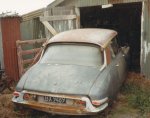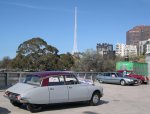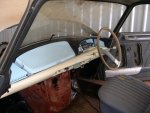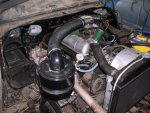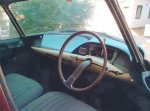I've posted snippets about this car previously but now that I'm fully committed to it's restoration I thought that it deserved a new thread.
It's a 1957 Slough-built DS19 that was originally delivered to a farmer in New Zealand. After a lurid road incident he parked it at around 50K miles. It went through a number of NZ "gunnas", until John Paas rescued it and imported it to Brisbane in 1997.
I bought it from Gilbert Henry in 2003 and got it to a mobile state (not registered and largely in primer) for the 50th anniversary of the DS at Federation Square Melbourne in 2005. Where, in front of thousands of onlookers it dropped onto 2 cylinders as I attempted to drive up into the square. #%@k, I'd just driven down Flinders St., and into Swanston St. in a unregistered, uninsured almost 50 year old Citroen. Clap, cheer people, cheer.
After the Fed Square event the car went into limbo in the farm shed while I concentrated on other projects. However last year I started to get back to into it. Much has been done, although not a lot to show. The whole dash area has been restored, the wiring sorted out and some work on the hydraulics. It now starts, runs and pumps up with no leaks and the next step is to sort out the gear changing. After that, we'll get some paint on it.
The first image is the DS19 being disinterred from it's first period of storage in NZ.
The second is at Fed Square in 2005.
A recent shot of the restored dash.
Today, checking the pressure of the low pressure pump.
roger
It's a 1957 Slough-built DS19 that was originally delivered to a farmer in New Zealand. After a lurid road incident he parked it at around 50K miles. It went through a number of NZ "gunnas", until John Paas rescued it and imported it to Brisbane in 1997.
I bought it from Gilbert Henry in 2003 and got it to a mobile state (not registered and largely in primer) for the 50th anniversary of the DS at Federation Square Melbourne in 2005. Where, in front of thousands of onlookers it dropped onto 2 cylinders as I attempted to drive up into the square. #%@k, I'd just driven down Flinders St., and into Swanston St. in a unregistered, uninsured almost 50 year old Citroen. Clap, cheer people, cheer.
After the Fed Square event the car went into limbo in the farm shed while I concentrated on other projects. However last year I started to get back to into it. Much has been done, although not a lot to show. The whole dash area has been restored, the wiring sorted out and some work on the hydraulics. It now starts, runs and pumps up with no leaks and the next step is to sort out the gear changing. After that, we'll get some paint on it.
The first image is the DS19 being disinterred from it's first period of storage in NZ.
The second is at Fed Square in 2005.
A recent shot of the restored dash.
Today, checking the pressure of the low pressure pump.
roger

